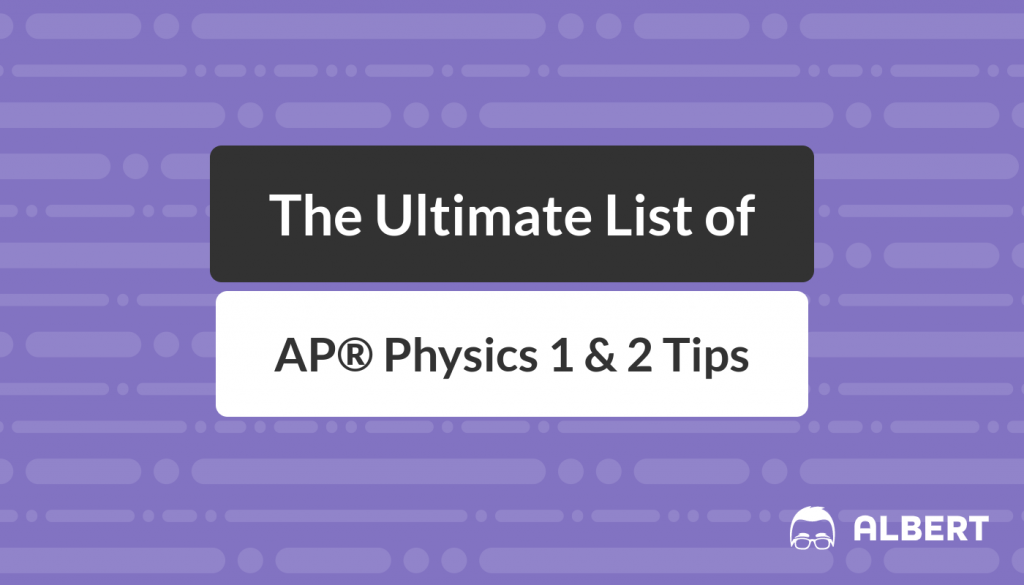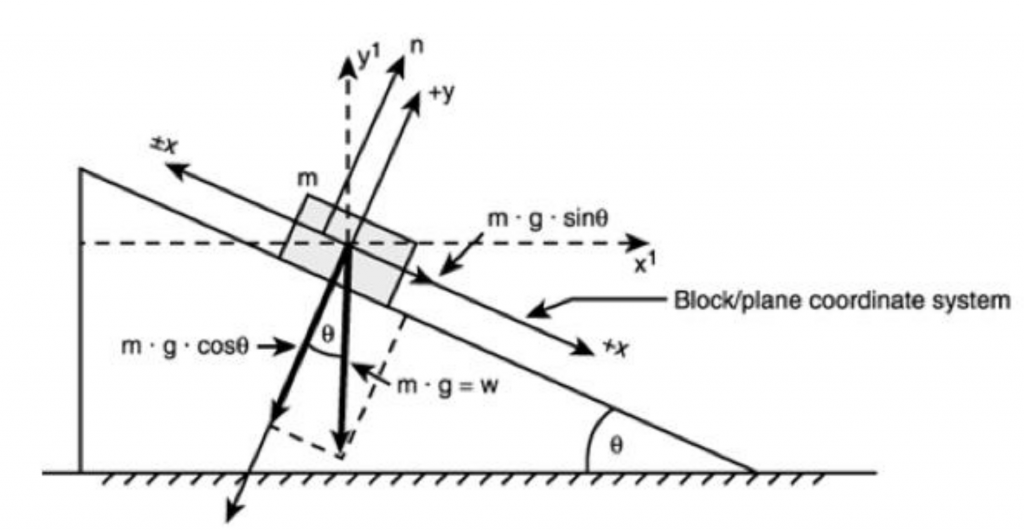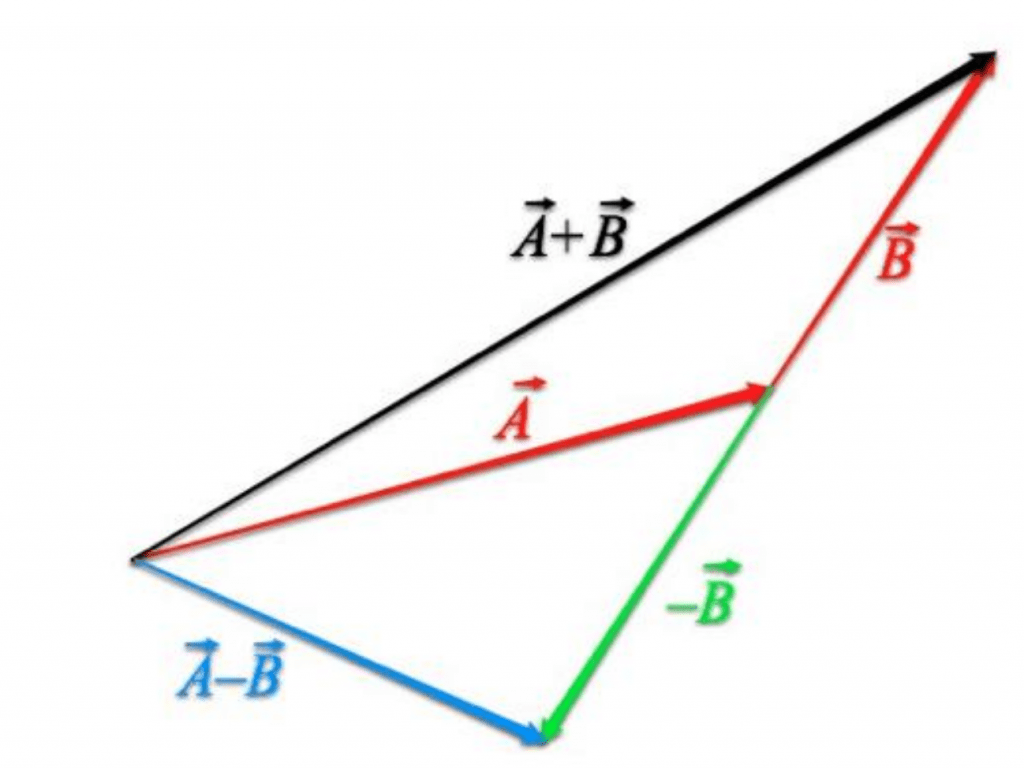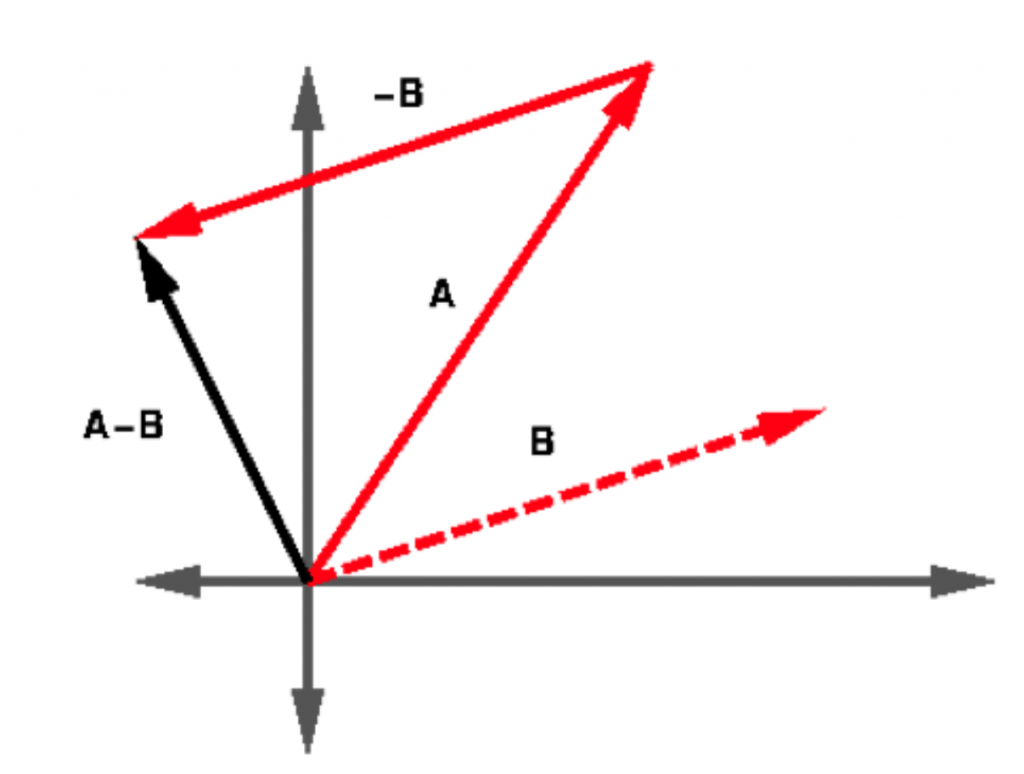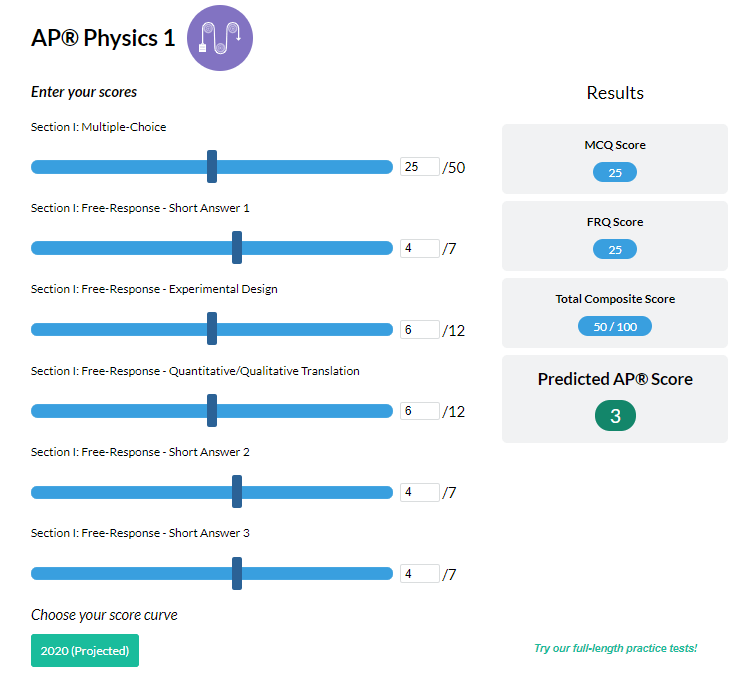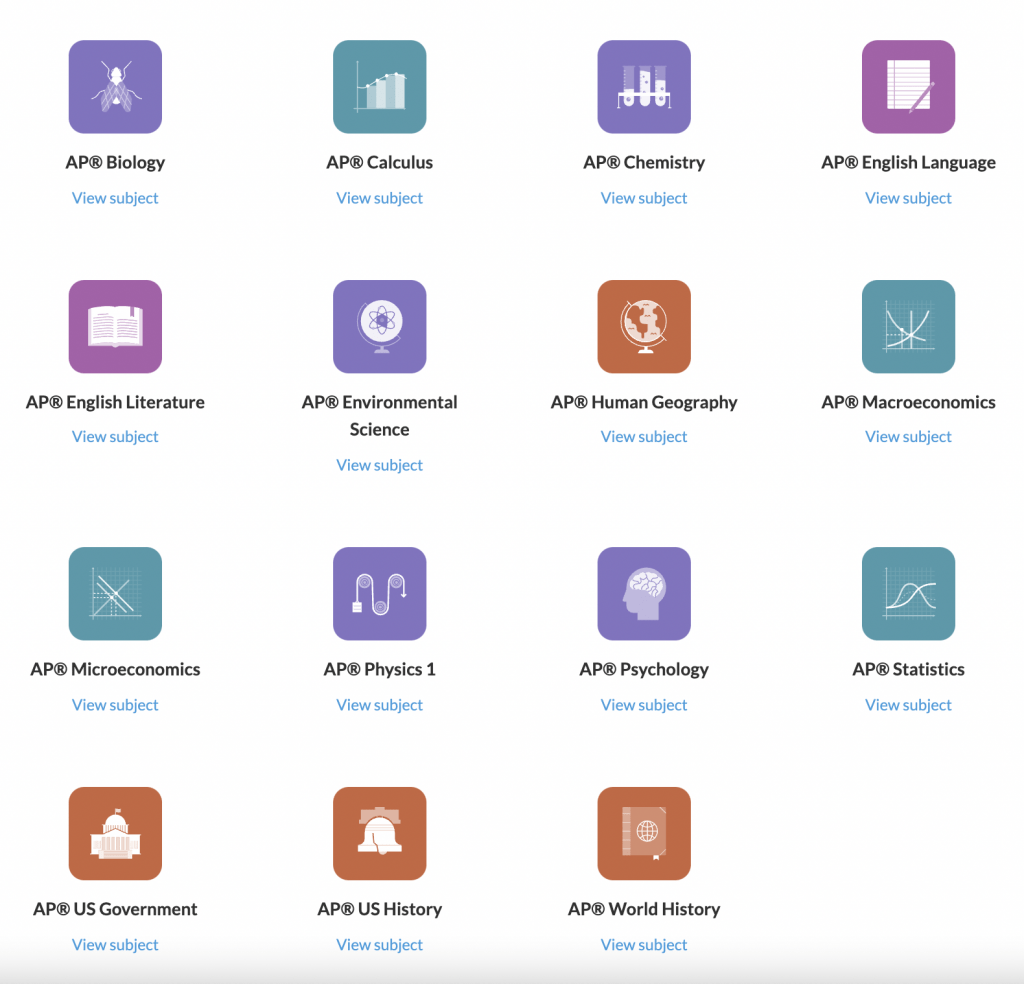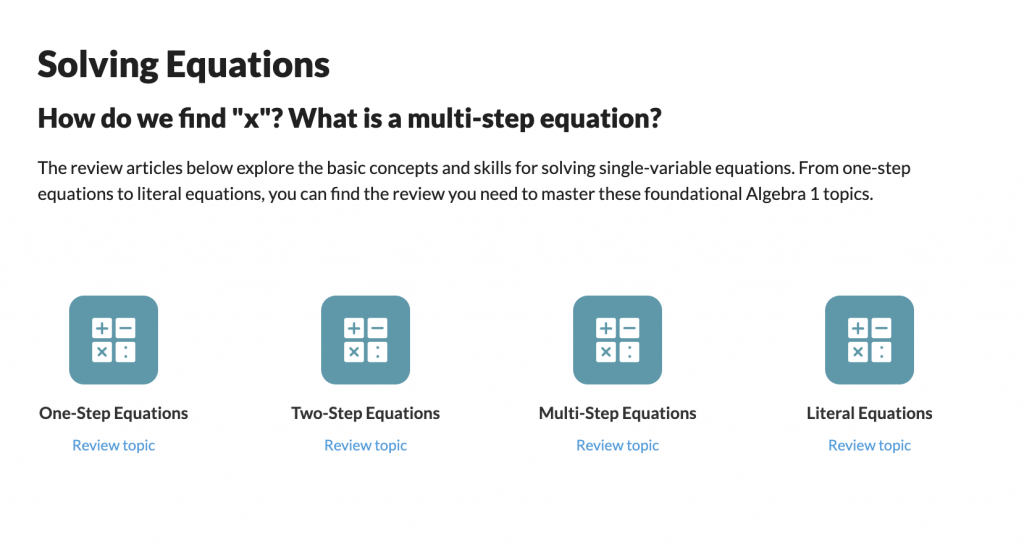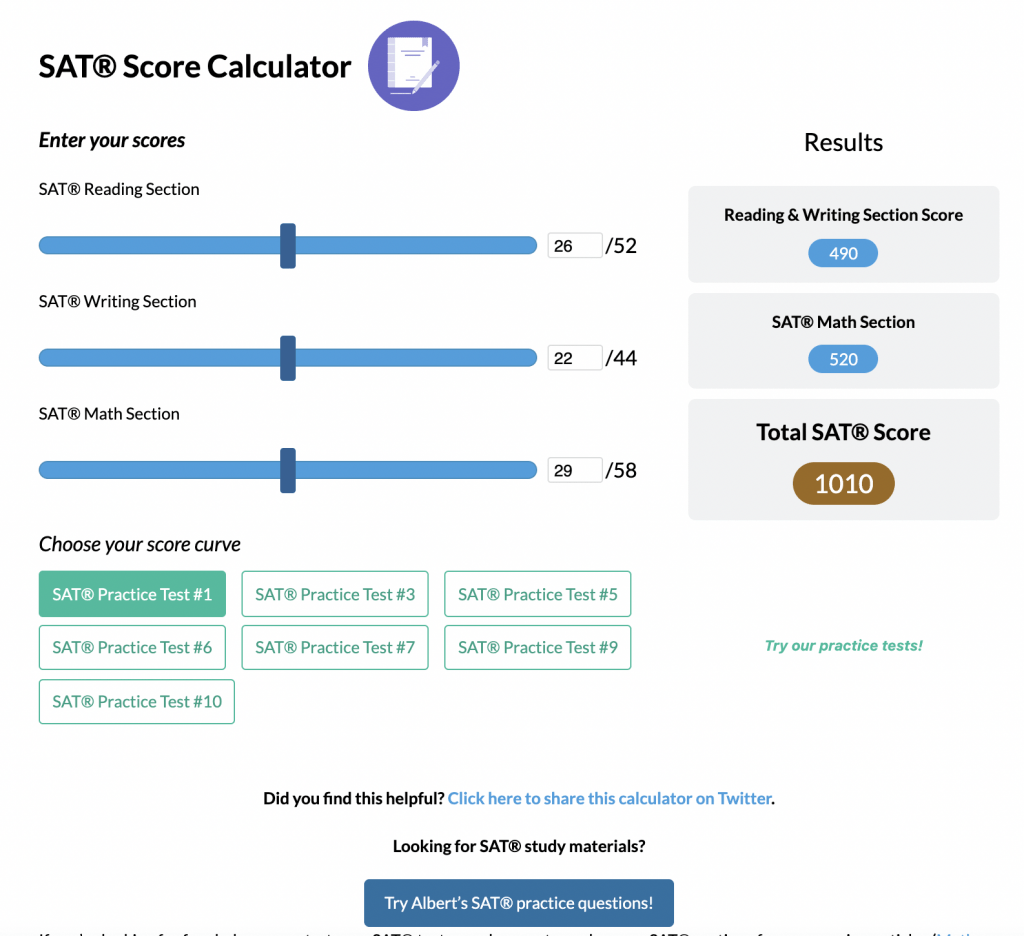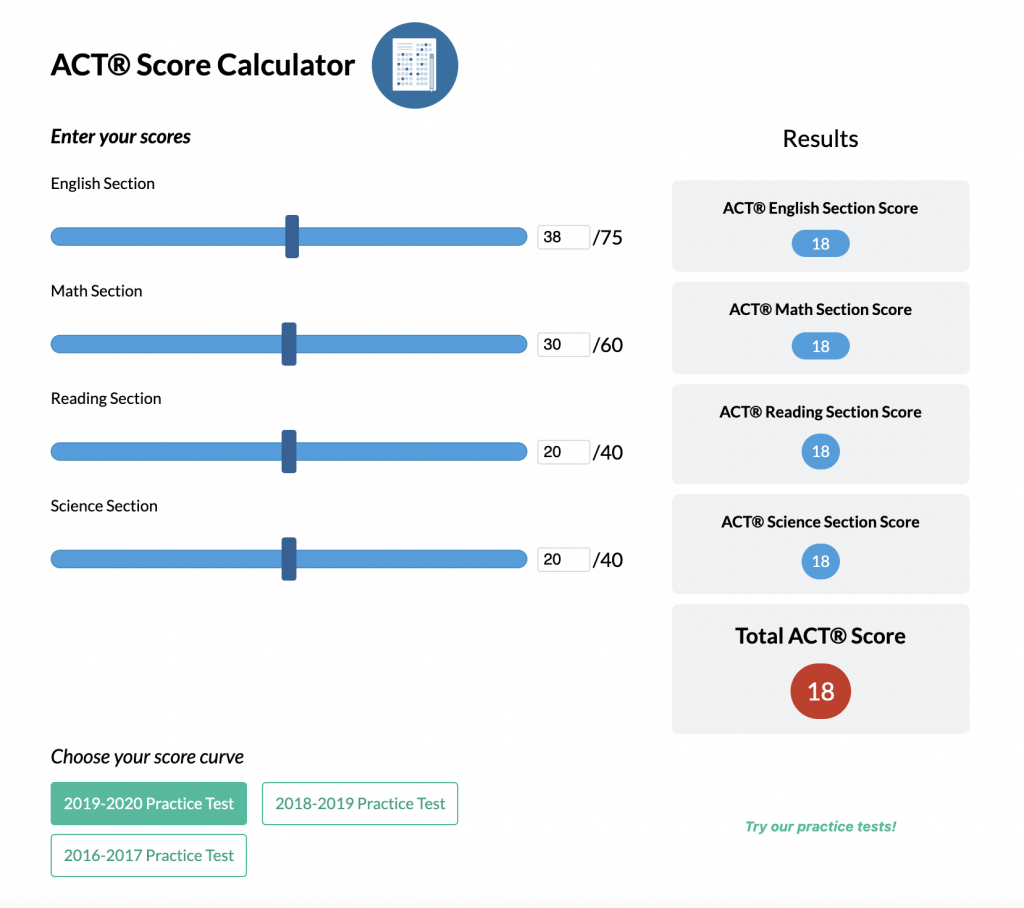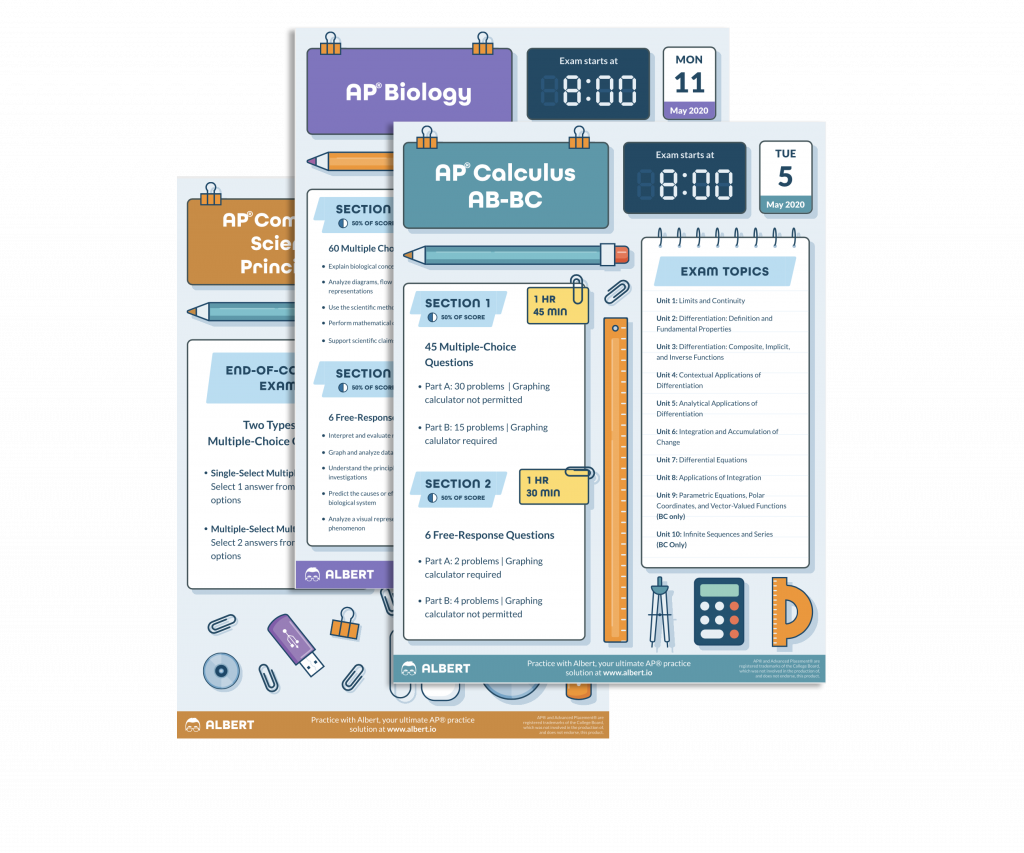In order for you to score a 4 or 5 on the AP® Physics 1 & 2 exams, it is important for you to follow the tips outlined below. In 2019, only 35.2% of students who took the AP® Physics 2 exam received a grade of 4 or 5. The AP® Physics 1 & 2 exams cover all of the topics in the previous AP® Physics B & C exams plus some additional ones as well.
Take the time to review the following tips which cover both the AP® Physics 1 & 2 exams, and you’ll be well on your way to earning the highest possible score on your AP® Physics exam. Relax, read and absorb the tips as you go! Good luck!
What We Review
How to Study for AP® Physics Exam: 7 Tips for 4s and 5s
1. Know the specific topics covered on the exam.
The AP® Physics exam will cover a number of specific concepts including Newtonian dynamics, circular motion, universal gravitation and much more. See the following tables for a list of topics and concepts covered in each of the AP® Physics exams:
AP® Physics 1
(See the AP® Physics 1 Course and Exam Description for more details.)
| Unit | Topics | Exam Weighting for MC Questions | Resources |
| Unit 1: Kinematics |
| 10-16% | |
| Unit 2: Dynamics |
| 12-18% | |
| Unit 3: Circular Motion and Gravitation |
| 4-6% | |
| Unit 4: Energy |
| 16-24% | |
| Unit 5: Momentum |
| 10-16% | |
| Unit 6: Simple Harmonic Motion |
| 2-4% | |
| Unit 7: Torque and Rotational Motion |
| 10-16% | |
| Unit 8: Electric Charge and Electric Force |
| 4-6% | |
| Unit 9: DC Circuits |
| 6-8% | |
| Unit 10: Mechanical Waves and Sound |
| 12-16% |
Return to the Table of Contents
AP® Physics 2
(See the AP® Physics 2 Course and Exam Description for more details.)
| Unit | Topics | Exam Weighting for MC Questions | Resources |
| Unit 1: Fluids |
| 10-12% | |
| Unit 2: Thermodynamics |
| 12-18% | |
| Unit 3: Electric Force, Field, and Potential |
| 18-22% | |
| Unit 4: Electric Circuits |
| 10-14% | |
| Unit 5: Magnetism and Electromagnetic Induction |
| 10-12% | |
| Unit 6: Geometric and Physical Optics |
| 12-14% | |
| Unit 7: Quantum, Atomic, and Nuclear Physics |
| 10-12% |
Return to the Table of Contents
The two separate AP® Physics exams are called AP® Physics 1: Algebra-Based and AP® Physics 2: Algebra-Based. Start reviewing and memorize the standard equations of rectilinear motion shown below:
v={v}_{0}+at
r={r}{0}+{v}{0}t+\dfrac{a{t}^{2}}{2}
r={ r }{ 0 }+(\dfrac { v +{ v }{ 0 } }{ 2 } )t
{v}^{2}={v}{0}^{2}+2a \left(r-{r}{0} \right)
r={r}_{0}+vt- \dfrac{g{t}^{2}}{2}
You will need these equations for all problems related to objects in motion. Review the concepts of distance, velocity and acceleration, and know how to use and apply them to a specific problem. You will often be given an initial distance, velocity or acceleration or any combination thereof. Take ALL the information given and place it on your worksheet. Assign values to all of the given variables and then decide which equation would be most appropriate to use.
Here are some examples of the types of rectilinear motion problems you will encounter:
- Finding final velocity given initial velocity and constant acceleration
- Finding final distance given initial distance, velocity and acceleration
- Finding acceleration given initial velocity, distance and time
- Finding the velocity of an object in free fall (acceleration = -g)
- Finding the distance of a projectile given an initial velocity and angle
- Finding the instantaneous velocity or acceleration of a rotating object
Study each topic individually. Try not to skip all over the place or study just one part of a unit. Focus your energy on a single topic until you master it completely before going onto the next topic. For example, know and completely understand how to use the equations of rectilinear motion before going to harmonic motion or work-energy problems. It is always best to master one topic before proceeding to the next.
Use a logical progression of steps when going through the topics. You might use the table provided or your course’s syllabus as a guide or road map to determine the order in which to study. Master the equations and concepts of kinematics first and then proceed to Newton’s Laws of Dynamics. Then proceed to the more advanced topic of circular motion which has similar concepts to kinematics except that it is focused on circular motion and the concepts of centripetal and centrifugal forces. The key is to master each topic individually before going to the next. Continually add to your AP® Physics 1 & 2 review packet as you work your way through the topics.
2. Visit Georgia State University’s Hyperphysics website.
We recommend the Hyperphysics website for their review of basic concepts and highly detailed illustrative diagrams. You will navigate intuitively throughout the website and study whichever physics topic your mind desires. The website is easy to navigate with its concept maps and other linking strategies. If you are struggling to understand a particular physics concept, it is a great idea to visit this site.
3. Search the Internet for physics problems.
Nowadays, a lot of teachers are providing their resources online. A few simple searches can lead you to class resources such as: Mr. Hansen’s Physics Class, Mr. Galich’s Physics, and Laufer Physics. Other websites focus on practice problems, such as APlus Physics and AP® Practice Exams. Find resources that you find helpful and easy to use. Consider what you want from the source: classroom links usually provide notes and some sample problems, other sites might focus on practice exams. Some sites also have questions that are already answered and will walk you through the various steps of the problem. Bookmark your favorites so that you can return to them any time. While most resources will be broken down by unit, if you need additional material, conduct searches using keywords such as “AP® Physics problems,” “sample kinematics problems,” “circular motion problems,” or other topics and phrases such as those outlined in the table in Tip 1.
4. Buy one or two recommended physics textbooks.
Check out a number of excellent textbooks listed on this website for AP® Physics 1 and AP® Physics 2. Make sure that the ones you choose cover the fields of physics you need the most help in. Most of the books will cover all of the topics covered on the AP® Physics exam. When you get them, read them carefully and do the problems listed at the end of each chapter to test your ability and competency. This will give you a good taste of what is to come when you actually take the exam.
5. Get a good calculator that has all of the common constants.
We highly recommend the Casio Fx-115 ES Plus. It contains even more universal physical, thermodynamic and electromagnetic constants than you will need. It also contains a way to convert metric units into English and vice versa.
Some of the constants you will need for the AP® Physics exam are the following: Newton’s gravitational constant, speed of light, permittivity of free space, masses of the electron, proton and neutron. If you have a graphing calculator that you want to use instead, make sure that it is on the list of approved graphing calculators.
6. Understand and memorize the following basic equations.
Memorize only the basic equations that you will need for the exam. The College Board has an excellent resource for this and it is broken down into all of the categories. You don’t need to memorize all the equations but you should at least know the basic ones for Newtonian mechanics, electricity & magnetism, optics (especially Snell’s Law as it relates to index of refraction), fluid mechanics, thermodynamic equations (i.e., specific heat), and atomic and nuclear physics.
Here is a list of some of the basic AP® Physics equations you should know:
| Velocity
\vec{ v }=\dfrac {\triangle s}{\triangle t}=\dfrac {ds}{dt} | Acceleration
\vec{a}=\dfrac {\triangle \vec {v}}{\triangle t }=\dfrac{d \vec{v}}{dt} | Newton’s Second Law
\vec{F} =m\vec{a} |
| Momentum
\vec{p} =m\vec{v} | Centripetal Acceleration
\vec{{a}_{c}} =\dfrac{{ \vec{v}}^{2}}{r} | Impulse Momentum
\vec{F} \triangle t=m\triangle \vec{v} |
| Kinetic Energy
{E}_{k}=\dfrac{m{v}^{2}}{2} | Power
P=\dfrac{\triangle W}{\triangle t} =\frac {dW}{dt} | Angular Velocity
\vec {\omega}=\dfrac{\triangle \theta}{ \triangle t}=\dfrac {d \theta}{dt} |
| Angular Acceleration
\vec {a}=\dfrac{\triangle \vec{\omega}}{\triangle t}=\dfrac{d \vec{\omega}}{dt} |
You need to know what the equations say and how to use them. The reason you are provided with a formula sheet is because CollegeBoard is trying to assess how deep your understanding of physics is and not how good your memory is. The only downside to this is that the problems will be harder to solve. Because you have this crutch to help you, concentrate more on the underlying principles and concepts of physics rather than memorizing all the formulas.
7. Know the difference between a scalar and a vector quantity.
In physics both scalar and vector quantities are common. A scalar only has a magnitude and a vector has a magnitude and a direction. A vector description is considered incomplete if it does not have a direction specified. Also, realize that equations employing vector quantities contain unit vectors. These unit vectors have a magnitude of one and are pointed in the same direction as the resultant vector. The most common equations employing vector quantities are those of motion (position, velocity and acceleration), angular velocity and acceleration, torque, angular momentum, force equations including Young’s modulus, universal gravitation and gravitational potential. For equations in electricity and magnetism employing vector quantities; these include Coulomb’s Law, electric field and potential equations, electric and magnetic flux and motional and induced EMF.
Return to the Table of Contents
AP® Physics Multiple-Choice Review Tips
AP® Physics is a three-hour exam broken into two sections, each section lasting ninety minutes long. Each section represents 50% of your total score. The multiple-choice section contains 50 multiple-choice questions and contains discrete items, items in sets and multi-select items (where two options are correct).
The multi-select questions are arguably the most difficult of all the multiple-choice questions so make sure to allocate more time on these. Beginning in May 2015, each multiple-choice question only contains four answer options rather than five.
1. Review the College Board AP® Physics 1 & 2 course and exam descriptions.
We highly recommend students prepare for the AP® Physics exam by reviewing the College Board’s course and exam description for Physics 1 and Physics 2. The documents contain many essential knowledge concepts that will significantly enhance your ability to solve problems and bolster your overall understanding of physics. Each unit and topic is connected back to the big ideas and science practices, as well as enduring understandings and learning objectives. This can be helpful to understand how units connect with and build on each other.
Additional resources are listed for each unit and personal progress checks are available in their online classroom. At the end of the documents, there is a section about the actual exam. In addition to logistical information such as a breakdown of the exam question topics, weighting, and scoring, there are sample exam questions that you might use to practice.
2. Practice common problems involving the force of friction.
In Newtonian mechanics, the force of friction or “inclined plane” problems is very common. Let’s take a simplified example where there is no inclined plane. Suppose we have a box that has a mass of 25kg and it takes a force of 75N to move it, what is its static coefficient of friction?
First we calculate the normal force F_n (which is simply the weight of the box) using the equation F_n=mg where g is the gravitational constant 9.8m/sec2. F_n=245N.
Then, to find the static coefficient of friction \mu we simply take the force needed to move the box and divide it by its weight to get \mu=0.306. Since \mu is the quotient of two forces of the same unit (Newtons), it is a unitless number. For inclined plane problems you must draw a detailed diagram showing the x and y components of the weight of the box as shown below:
3. Know the common units of the major quantities in both the CGS and MKS systems.
The units of each variable in an equation should be known and understood. There is an entire section of physics known as unit or dimensional analysis. When you perform a complex calculation you need to follow through on your units. Make sure that you are consistent with the units of either system when doing problems. If the problem starts out in MKS units make sure you solve the problem in those units. If you need to convert from one system to another, make sure you are doing it properly. Consider studying the following table which gives some of the most common units used in physics in both systems or making a table of your own.
| Quantity | MKS Unit | S.I. Equivalent | CGS Unit | S.I. Equivalent |
| Force | newton (N) | \dfrac{\text{kg}\cdot \text{m}}{\text{s}^2} | dyne (dyn) | \dfrac{\text{g}\cdot \text{cm}}{\text{s}^2} |
| Energy | joule (J) | \dfrac{\text{kg}\cdot \text{m}^2}{\text{s}^2} | erg | \dfrac{\text{g}\cdot \text{cm}^2}{\text{s}^2} |
| Magnetic flux density | telsa (T) | \dfrac{\text{N}}{\text{A}}, \dfrac{\text{kg}\cdot \text{m}}{\text{A}\cdot \text{s}^2} | gauss (G) | \dfrac{0.1\text{dyn}}{\text{A}}, \dfrac{0.1\text{g}\cdot \text{cm}}{\text{A}\cdot \text{s}^2} |
4. Make diagrams for certain problems.
Many problems on AP® Physics are best tackled drawing a small diagram. This is especially important if you are asked to calculate a force in a particular direction. Draw a coordinate axis and any vectors or component vectors on the diagram. Mark each vector with a symbol having a defining subscript. For example, the component force of acceleration in the x direction should be denoted as a_x.
Place ALL the data given in the problem onto the diagram. As you are solving the problem, place any interim data that you have calculated onto it as well. If you do it this way you will not get lost or waste valuable time working out the details.
5. Dissect multi-select questions.
There will only be five multi-select questions on this part of the exam. Get a firm grasp of the question and then find the best two answers. Gather your thoughts and the crucial concepts of the question and read each answer carefully. If you find one that is obviously wrong, cross it out or mark an “X” next to it. Use the process of elimination to the best of your ability. Draw a diagram or write down an equation that may be relevant to the question. With the equation written down it will be much easier for you to determine whether one variable is decreasing or increasing and what effect that will have on the variable pertaining to the question.
6. Review important conservation relationships.
All quantities in dynamic physics are conserved. For example, in a collision between two objects, linear momentum is conserved. However, if the collision is inelastic, the kinetic energy (and also the momentum) before and after the collision are not the same although the total energy of the system is always conserved.
In the inelastic case, some of the energy of the collision is taken away by internal friction and is dissipated as heat energy. The conservation of momentum relation applies to angular momentum as well (both on the macro and subatomic quantum levels). The conservation of momentum and energy are fundamental laws of physics. You will need to use them frequently when solving many problems in physics.
7. Know and understand the relationship between work, energy and power.
Work refers to an activity involving a force in the same direction of the force (e.g., a force of 200 Newtons pushing an object 10 meters in the same direction of the force has performed 2,000 Joules of work). Energy refers to the “capacity of doing work”. In other words, you need a certain amount of energy to perform a certain amount of work. Using the example, we needed 2,000 Joules (2kJ) of energy to perform the task of pushing the object.
Power is simply the rate of doing work, or the rate of using energy, and is the amount of work that is done during a certain amount of time P=\dfrac{W}{\triangle t}. In our example above, if it took us 2 seconds to move the object, the amount of power that was output was 1,000 Watts or 1kW.
8. Practice drawing vector diagrams and know how to add and subtract them.
Vector diagrams and vector algebra are at the very heart of physics. It is crucial to know how to add and subtract vectors graphically using the head-to-tail approach starting at the origin of a Cartesian coordinate axis and to draw the correct resultant vector.
For vector addition it does not matter which vector you draw first since addition is commutative. For subtraction, however, make sure that the vector you draw first is the one you are subtracting from. The next step(s) are the same as addition. Place the tail of the second vector at the head of the first one. Continue doing this until you have all the vectors in place. Then simply draw a line from the origin to the head of the final vector. This line will be the resultant vector of the subtraction. See the example below:
The above figure shows the resultant vector sum \vec{A}+\vec{B} in black and the resultant vector subtraction \vec{A}-\vec{B} in blue.
Below is another figure illustrating the subtraction of two vectors. Notice that the negative value of a vector points 180⁰ away (parallel and opposite) from its positive counterpart:
9. Use Kirchoff’s Loop Law for electric circuits.
The AP® Physics 1 exam introduces simple electrical circuits employing only resistors whereas the AP® Physics 2 exam includes circuits containing RC components. The student needs to understand Ohm’s Law (E = IR) and the conservation of electrical charge (voltage energy) and currents in closed electrical DC circuits. Kirchoff’s Law is broken up into two parts: Kirchoff’s Current Law (KCL) and Kirchoff’s Voltage Law (KVL). Check out Albert’s practice problems here.
Return to the Table of Contents
AP® Physics Free Response Question Review Tips
There are five Free Response Questions (FRQs) on the AP® Physics 1 exam. There is one based on experimental design, another related to quantitative and qualitative translation and another three that are short answers. The AP® Physics 2 exam also has one FRQ based on experimental design, one on quantitative and qualitative translation, and only two short answer type questions. In scoring the FRQs, credit for the answers depends on the quality of the solutions and the explanations given.
Partial solutions may receive partial credit so it is important to show all your work. A table of information and equations needed for the exam are available for students at least one year before the exam. You will be given the exact same information (values of physical constants, etc.) and equations when you take the exam. You cannot bring your own copy to the exam. See the Appendix on page 235 for AP® Physics 1 and AP® Physics 2.
1. Use paragraph length responses.
Some FRQs on the AP® Physics exam will require you to provide a coherent, organized and sequential description of the situation presented. If so, provide an accurate, concise, and factually based response to the question in the form of a paragraph utilizing prose. Make sure that you do not add any erroneous information or subject matter. Read the question carefully and focus on answering all parts of the question in the order that they appear.
2. Cite physical principles and equations.
Style your exposition in a simple manner to describe and/or explain in a short paragraph what the question is asking for. Also, only use the appropriate equations and principles needed to answer the question. Focus only on answering the question and avoid any digression(s).
You will lose credit if you only write down a bunch of equations without any written explanation. Use diagrams, equations, graphs and calculations to support your line of reasoning. Keep your paragraph(s) short to moderate in length and make sure that they make sense on the first reading.
3. Describe and explain questions.
Utilize your skills in writing and in depth knowledge of physical principles to answer these types of questions. Justify your answers by using an argument which is supported by key evidence. The evidence should include the fundamental law(s) of physics, diagrams, graphs, equations, calculations and data. This is a very important AP® Physics 1 & 2 FRQ tip.
4. Draw a free-body diagram for mechanics and motion problems.
Draw a free-body diagram for questions involving inclined plane problems, motion problems, pulley problems and any other problems having a number of vector components. In this manner, you will be able to better visualize all of the forces at a glance. Clearly indicate all the forces and their components. Use appropriate units for the numerical values of any physical quantities. Leaving out units, and directions in the case of vectors, will cost you points!
5. Skim all the problems prior to solving.
Take a minute or two to quickly skim the FRQs to get an assessment or indication of which question looks easier to answer. You will likely see one or two that you feel more comfortable with so you should start on those problems first. Gauge your time to about 15 minutes for each problem.
6. Form an AP® Physics study group of your peers.
Schedule a time and place where you can get together with classmates to discuss and solve physics problems. It doesn’t need to be a formal or weekly thing but at least communicate with them and try to meet each other from time to time. Ask them if they would be open to you calling them whenever you are having difficulty with a particular problem. You may be able to help them and they may be able to help you.
7. Underline all interim solutions.
If an FRQ asks you to calculate a certain quantity which involves several steps (and most will), underline or otherwise mark numerical values that you will be using in subsequent calculations. If you are asked to derive an equation from basic principles, make sure that you underline OR better yet, number the equations in each step of the derivation. This way you can refer to each numbered step when providing your written paragraph explaining or justifying your final answer.
8. Indicate all relevant equations, steps and principles (Laws).
When answering any FRQ, it is important to show all of the equations, interim answers with the correct values and units. Since the answer to an FRQ is in a paragraph format, make sure that you indicate any core principles or key Laws of Physics that you used in order to solve or to explain the problem. We recommend drawing a box around any key interim equations or answers.
9. Use prose for paragraph responses.
The style of your paragraph is important for both the AP® Physics 1 & 2 exams. You must present the principles used for each FRQ in a logical manner. If the principles are out of order and you use lengthy and meaningless arguments or explanations, you will lose points. You need to write the paragraph in expository form using prose so as to guide the reader logically and clearly to the correct answer. Use correct prose so that the sentences flow naturally. Be succinct but to the point. Do not add any irrelevant information as this will cause you to digress from the subject matter and lose points.
Return to the Table of Contents
Tips by AP® Physics Teachers
1. Practice and review your math skills.
Since physics is applied math, being deficient in your aptitude in math will be a detriment in your ability to solve problems in physics. Review your math skills especially in the areas of advanced algebra and trigonometry. Also, review graphing methods for polynomial expressions and trigonometric functions. More importantly, know how to graph equations in both Cartesian (x, y, z) and Polar coordinates (r,\theta, \varphi ). Polishing up your adeptness in math will ensure a much smoother transition in applying it to physics and will improve your chances of getting a higher score on the AP® Physics exam.
2. Form a clear study plan weeks ahead of time.
Schedule time to study that isn’t part of your typical study time for class. Maybe preview new material before you get there. Inside of your study plan, students should develop methods for assessing their knowledge. Then based on their self assessment, they should re-design their plan to help themselves master the concepts. Most importantly, students should NOT try to cram. Physics is a subject that you cannot cram for. What you know on test day likely was developed months in advance. Thanks for the tip from Ross G.
3. Identify the topics you have difficulty with.
When solving problems, you may very likely come to a road block. You may be stuck for one or both of the following reasons:
- a. You don’t know what equation(s) to use. In this case, do the following. Write down the given variables and their numeric values from the question. Next, go to the list of equations here (also listed in the Appendix of the Course and Exam Description on page 235) and identify which equation uses those given variables and the variable that you need. Doing this will identify at least one or two equations as possibilities. Choose the equation(s) and attempt to solve the problem again. If you are still having trouble, review the basic concepts for the specific topic and try again.
- b. You know what equation(s) to use but you seem to be missing a variable or two. This usually happens when you are presented with a large word problem such as those in the FRQs. Often they will not explicitly give the variables you need. Instead they will use wording that you need to dissect in order to extract the variable.
For example: A car traveling north for 30 km reaches its initial destination in 30 minutes. It then changes course and travels at 40 km east and reaches its final destination in 30 minutes. Using vector addition, find the resultant velocity of the car. For this question you need to calculate the two velocities (north and east) individually and perform the vector addition. So the two velocity vectors to add are:
\vec{{v}_{N}}=\dfrac{30km}{0.5hr}=60\dfrac{km}{hr} North
and
\vec{{v}_{E}}=\dfrac{40km}{0.5hr}=80\dfrac{km}{hr} East
It turns out that the resultant velocity vector is the hypotenuse of a 3,4,5 right triangle and the answer is: \vec{{v}_{R}}=100\dfrac{km}{hr} in the direction 53.13⁰ east of north.
4. Practice your pacing.
For example, if you know the AP® test has 5 free response problems over the course of 90 minutes, then practice doing one free response problem in 18 minutes. The worst scenario is a student not understanding the pacing needed to adequately work through the test. Never sit and stare at a problem. Have a plan and follow it: identify what you know, draw a diagram, identify the topic, use an equation if necessary, and show your work. If you get stuck, move on so that you at least see all of the questions on the exam. Thanks for the tips from Stacy S. and Douglas P. at Upper St. Clair High.
5. Focus on your conceptual understanding.
One teacher even assigns every conceptual question in his textbook for his class to practice. Once you exhaust your textbook, find more conceptual problems online and solve those. Challenge your classmates by thinking up “what if” questions. Class discussions over conceptual questions usually lead students to have a deeper understanding of the Physics concepts. Knowing the fine details of a concept is what really gives insight into difficult problems. Thanks for the tip from Ross G. and Bill S. at AC Reynolds High.
6. Annotate and review your equation sheet.
Write out “key words” that indicate a certain type of problem on the equation sheet. Then practice, review and re-write the annotated equation sheet throughout the year to help remember all topics throughout the course of study so nothing goes too long without being reviewed. Thanks for the tip from Stacy S.
7. Don’t memorize how to do problems.
Use the laws and principles to get your solutions from scratch. As you solve, write down every step. Pretend your grader doesn’t know anything about physics. This way you cover all conceptual ideas, but care must be taken to be proficient at completing questions quickly without sacrificing accuracy. Students who excel on the exam have figured out how they can identify what a question is asking and then answer it quickly without making the errors many students make when they start to race against the clock. Thanks for the tip from Takoa L., Rachel H., and Todd C. from Brea Olinda High.
8. Keep It Simple Silly!
With every complex question, it can be broken down into the different simple concepts and then solved using those concepts. The questions are not there to trick or confuse you, but to give you an opportunity to show your knowledge. Break it down and show every step along the way. In fact, you might use a scaffolding equation to help make decisions.
For example, if P triples while T is increased by a factor of 15 what happens to the volume of an ideal gas in a sealed container. Writing out the scaffold PV=nRT or PV=NkT will provide a good framework for working out the solution. Thanks for the tips from Ari E. and Andrew C. from Canyon Crest Academy.
9. Perform each problem in a stepwise fashion.
This is especially important for the FRQ portion AP® Physics exam, but it might also help during multiple-choice questions if you make a mistake or want to double check your work. The FRQs require you to follow a logical and step-wise process. Remember, you are utilizing several concepts or equations to answer multiple questions (usually 4 or 5).
Follow a natural progression when solving the problem and try not to skip any steps. Beau W. recommends explaining what is happening in words, preparing graphs of what is happening, using formulas to calculate what is happening, and connecting the verbal, graphical and algebraic descriptions.
10. Label all vectors properly.
We’ve repeated this in every section because it’s a simple mistake that many students make and lose valuable points on the AP® Physics exam. Label all of your diagrams, including variables and units. Always place a small arrow above the variable’s letter if it is a vector quantity and indicate its direction. See some examples below:
\vec{v}=80\dfrac{km}{s}\quad Northeast;
\vec{a}=30\dfrac{km}{{s}^{2}}\quad at, 60^{\circ}
\vec{a}=20\dfrac{km}{{s}^{2}}\quad at, 45^{\circ}
11. Use negative g (a= -g) in acceleration due to gravity equations.
This is another very common mistake by students in physics. When using equations involving the acceleration due to gravity, remember to change the sign from positive to negative in the equation. The force of gravity and the acceleration due to gravity points down towards earth and thus needs to be a negative value in these equations.
12. Avoid pronouns in the writing section and end your conclusion in the experiment question with “if the data gives this then the conclusion must be that the claim is true.
If the data says instead that then the conclusion is false.” Use if-then statements to bring together results and conclusions. Too many students lose points because they did not attach a conclusion at the end of the result statement. Thanks for the tip from Wayne M.
13. Conservation of Energy applies to everything!
There are applications to this main concept all over the AP® Physics exam… including applications to kinematics (projectile motion). Even in kinematics, you can use the idea of conservation of energy, and then cancel the masses to solve. Thanks for the tip from Kristin C. at Southwest High and Melissa D.
Return to the Table of Contents
Are you a teacher or student? Do you have an awesome tip? Let us know!
Wrapping Things Up: The Ultimate List of AP® Physics 1 & 2 Tips
The AP® Physics exam is notorious amongst the AP® science exams for its tough content and extensive reading list. Still, every year thousands of students take this course and pass the exam, earning valuable experience with complex physics in addition to college credit. If physics is your passion and you hope to study it at the college level, or even if you just really love physics and are looking for another outlet, this course and exam is for you. Don’t get bogged down in the details of the exam but enjoy the problems that you solve and study in class. Think about them in terms of their amazing scientific contributions to today’s technological advancements. Get lost in the amazing power of physics and you will undoubtedly find success on the AP® Physics exam.
We hope you have found this AP® Physics review guide useful. If you worked hard throughout the year in your class, have built out a good AP® Physics study guide using the advice and resources provided here, and have practiced extensively (using lots of AP® Physics practice questions and AP® Physics practice tests), you should feel positive and confident that you have what it takes to earn a strong score. Good luck!

